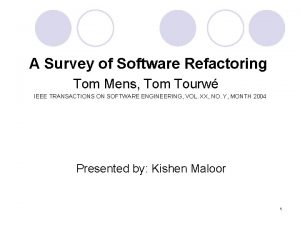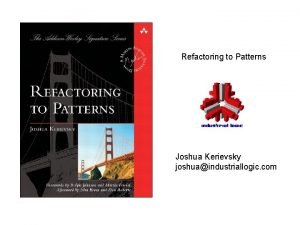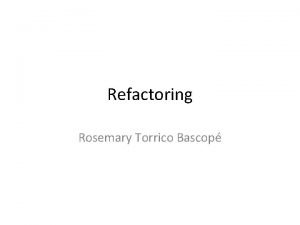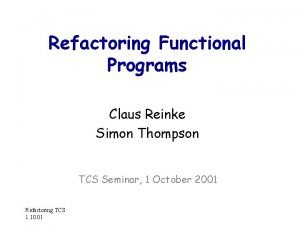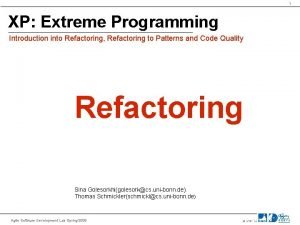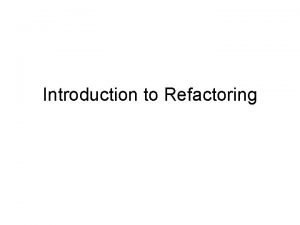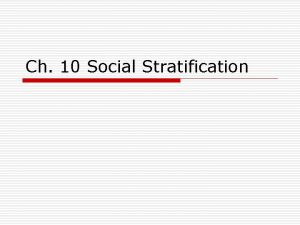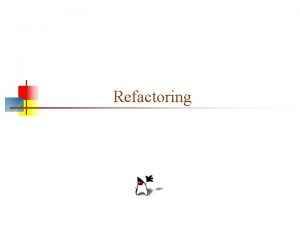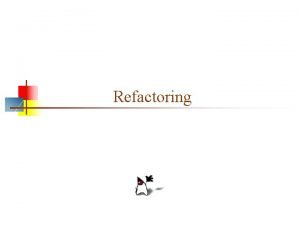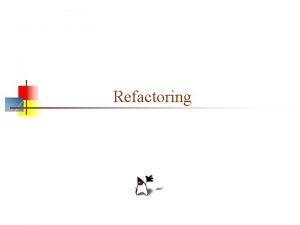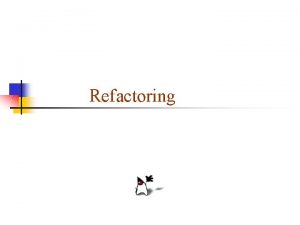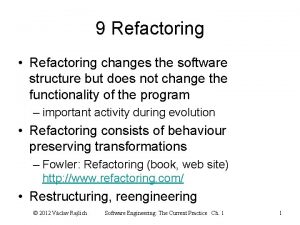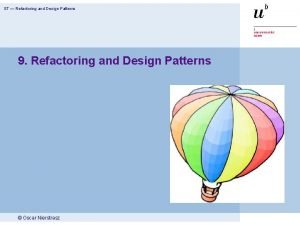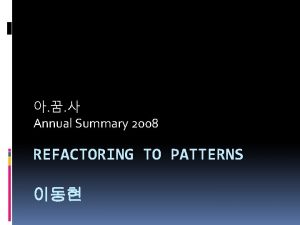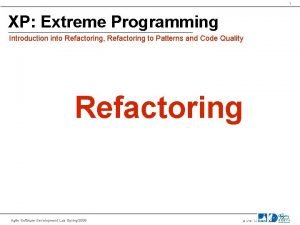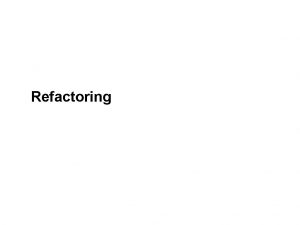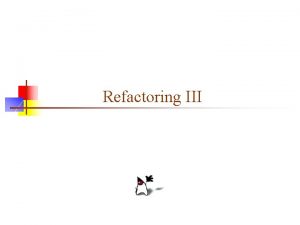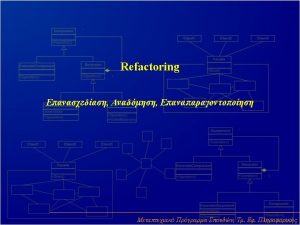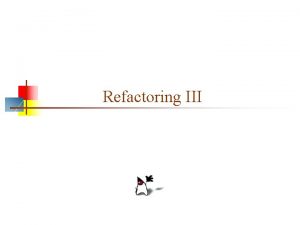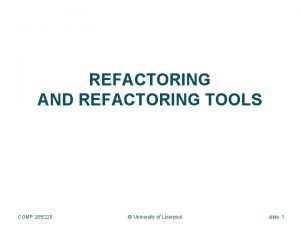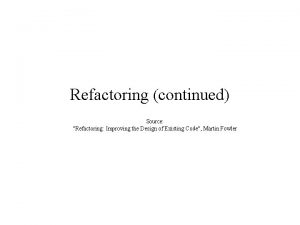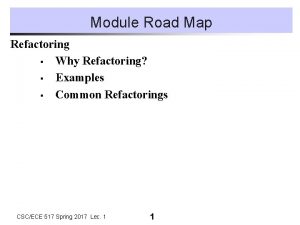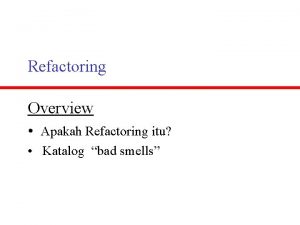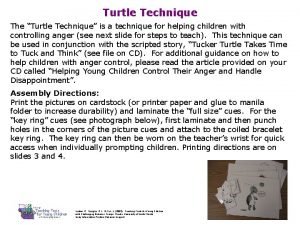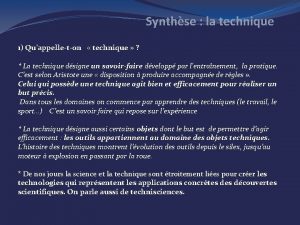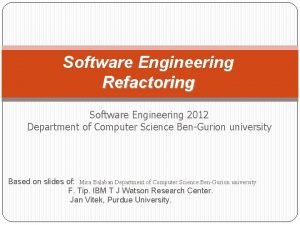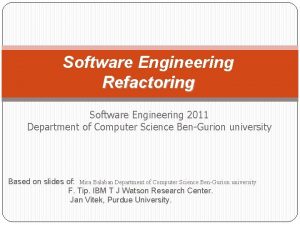A REFACTORING TECHNIQUE FOR LARGE GROUPS OF SOFTWARE




























































- Slides: 60

A REFACTORING TECHNIQUE FOR LARGE GROUPS OF SOFTWARE CLONES (MASTER THESIS DEFENSE) Asif Al. Waqfi Supervised by: Dr. Nikolaos Tsantalis Department of Computer Science and Software Engineering Faculty of Engineering and Computer Science Concordia University

INTRODUCTION Software Maintenance is the last step in System Development Life Cycle (SDLC) Duplicate Code Increase maintenance effort and cost [Lozano. ICSM 2008] Error proneness when clones are updated inconsistently [Juergens. ICSE 2009] Code instability [Mondal. ACM 2012] Software Refactoring 2

MOTIVATION Amount of clones in the systems Researchers reported that clones in systems range between 5% to 50% of the systems code base. Lack of mature and reliable clone refactoring tools Support specific clone types Other limitations Developers care about duplicate code and they try to avoid duplicate code when performing maintenance tasks. [Yamashita. USER 2013, Silva. FSE 2016] 3

CLONE TYPES Clone Type I 4

CLONE TYPES Clone Type II 5

CLONE TYPES Clone Type III 6

CLONE TYPES Clone Type IV void loop. Over (int var){ while(var > 0) { System. out. println(var); var--; } } void loop. Over (int var){ if(var > 0) { System. out. println(var); loop. Over(--var); } } 7

THESIS GOAL We ran 4 clone detection tools on 9 open source projects: 31% of the reported clone groups contain more than 2 clone instances. Refactoring Clone Groups 8

APPROACH 9

APPROACH Clone Parsing Clone Groups Refactorability Assessment Project Parsing Information Extraction Statement Alignment Project Clustering Clone Detection Tool Common Structure Sub Groups Differences Pairwise Matching 10

APPROACH Clone Parsing Clone Groups Refactorability Assessment Project Parsing Information Extraction Statement Alignment Project Clustering Clone Detection Tool Common Structure Sub Groups Differences Pairwise Matching 11

INFORMATION EXTRACTION (DATA TYPE, EXAMPLE) url = get. Item. URLGenerator(row, column). generate. URL(dataset, row, column); Assignment Left-Side: Identifier name: url Data Types (Including Super types): Char. Sequence, String Assignment Right-Side (Method Call): Method name: get. Item. URLGenerator(row, column). generate. URL Return Data Types (Including Super types): Char. Sequence, String Parameters Data Types: ({Interval. Category. Dataset, Keyed. Values 2 D, Dataset, Category. Dataset, Gantt. Category. Dataset, Values 2 D}, {int}) 12

APPROACH Clone Parsing Clone Groups Refactorability Assessment Project Parsing Information Extraction Statement Alignment Project Clustering Clone Detection Tool Common Structure Sub Groups Differences Pairwise Matching 13

CLUSTERING Clone detection tools might report clone groups having dissimilar clone instances, affecting the refactorability of the group as a whole. For instance, token-based and text-based detectors don’t validate the control statements in the clones, one could be an If while the other is a For. The goal of clustering step is to create smaller groups that their clone instances: Have a common control structure. Less different. 14

Clone (1) 1. 2. 3. 4. if (state. get. Info() != null) { Entity. Collection entities = state. get. Entity. Collection(); if (entities != null) { String tip = null; EXAMPLE 5. if (get. Tool. Tip. Generator(row, column) != null) { 6. tip = get. Tool. Tip. Generator(row, column). generate. Tool. Tip( dataset, row, column); } 7. String url = null; 8. if (get. Item. URLGenerator(row, column) != null) { 9. url = get. Item. URLGenerator(row, column). generate. URL(dataset, row, column); } 10. Category. Item. Entity entity = new Category. Item. Entity(bar, tip, url, dataset, dataset. get. Row. Key(row), dataset. get. Column. Key(column)); 11. entities. add(entity); } } Clone (2) 1. 2. 3. 4. 5. 6. 7. if (state. get. Info() != null) { Entity. Collection entities = state. get. Entity. Collection(); if (entities != null) { String tip = null; Category. Tool. Tip. Generator tipster = get. Tool. Tip. Generator(row, column); if (tipster != null) { tip = tipster. generate. Tool. Tip(dataset, row, column); } 8. String url = null; 9. if (get. Item. URLGenerator(row, column) != null) { 10. url = get. Item. URLGenerator(row, column). generate. URL(dataset, row, column); } 11. Category. Item. Entity entity =new Category. Item. Entity(bar, tip, url, dataset, dataset. get. Row. Key(row), dataset. get. Column. Key(column)); 12. entities. add(entity); } } Clone (3) 1. 2. 3. 4. 5. 6. 7. if (state. get. Info() != null) { Entity. Collection entities = state. get. Entity. Collection(); if (entities != null) { String tip = null; Category. Tool. Tip. Generator tipster= get. Tool. Tip. Generator(row, column); if (tipster != null) { tip = tipster. generate. Tool. Tip(data, row, column); } 8. String url = null; 9. if (get. Item. URLGenerator(row, column) != null) { 10. url= get. Item. URLGenerator(row, column). generate. URL(data, row, column); } 11. Category. Item. Entity entity = new Category. Item. Entity(bar, tip, url, data. get. Row. Key(row), data. get. Column. Key(column)); 12. entities. add(entity); } } Clone (4) 1. 2. 3. 4. 5. 6. 7. if (state. get. Info() != null) { Entity. Collection entities = state. get. Entity. Collection(); if (entities != null) { String tip = null; Category. Tool. Tip. Generator tipster = get. Tool. Tip. Generator(row, column); if (tipster != null) { tip = tipster. generate. Tool. Tip(data, row, column); } 8. String url = null; 9. if (get. Item. URLGenerator(row, column) != null) { 10. url = get. Item. URLGenerator(row, column). generate. URL(data, row, column); } 11. Category. Item. Entity entity = new Category. Item. Entity(bar, tip, url, data, data. get. Row. Key(row), data. get. Column. Key(column)); 12. entities. add(entity); } } 15

CLUSTERING (COMMON STRUCTURE) Clone (1) Clone (2) 1. if (state. get. Info() != null) { 2. Entity. Collection entities = state. get. Entity. Collection(); 4. String tip = null ; 1. if (state. get. Info() != null) { 2. Entity. Collection entities = state. get. Entity. Collection(); 3. if (entities != null) { 5. if (get. Tool. Tip. Generator(row, column) != null) { tip = get. Tool. Tip. Generator(row, column). generate. Tool. Tip( dataset, row, column); 7. } String tip = null; Category. Tool. Tip. Generator tipster= 7. tip = tipster. generate. Tool. Tip(data, row, column); 8. String url = null; 8. if (get. Item. URLGenerator(row, column) != null) { 9. url = get. Item. URLGenerator(row, column). generate. URL(dataset, row, column); 4. 5. } 9. if (get. Item. URLGenerator(row, column) != null) { 10. url= get. Item. URLGenerator(row, column). generate. URL( } 12. entities. add(entity); 1 } } data, row, column); } 11. Category. Item. Entity entity = new Category. Item. Entity 10. Category. Item. Entity entity = new Category. Item. Entity(bar, tip, url, 11. dataset, dataset. get. Row. Key(row), dataset. get. Column. Key(column)); 11. entities. add(entity); get. Tool. Tip. Generator(row, column); 6. if (tipster != null) { 6. (bar, tip, url, data. get. Row. Key(row), data. get. Column. Key(column)); } } 1 3 5 3 8 6 9 16

CLUSTERING (COMMON STRUCTURE) 5 Clone (1) Clone (2) 1 1 3 3 8 6 9 17

5 1 1 3 3 Clone 1 8 ? 6 Clone 2 1 3 9 = 6 ? 6 Clone 3 = 1 1 1 3 3 3 Clone 2 Clone 1, Clone 2 9 6 Clone 3 9 Clone 1, Clone 2, Clone 3 9 6 Clone 4 9 Clone 1, Clone 2, Clone 3, Clone 4 18

APPROACH Clone Parsing Clone Groups Refactorability Assessment Project Parsing Information Extraction Statement Alignment Project Clustering Clone Detection Tool Common Structure Sub Groups Differences Pairwise Matching 19

CLUSTERING (DIFFERENCES) This step of clustering is done by: 1. Compute distance matrix. 2. Apply Hieratical clustering. In each round in Hieratical clustering a merge is done and Silhouette Coefficient is computed. 3. Clusters with the highest Silhouette Coefficient are selected. Silhouette Coefficient A measurement that is used to measure and estimate the consistency and quality of clusters. The closer Silhouette Coefficient to 1 the less the dissimilarity within the same cluster and greater to the other clusters so we can say it is well-clustered. 20

EXAMPLE Clone(1) Clone(2) Clone(3) Clone(4) Clone (1) (2) (3) (4) (1) 0. 0 14. 0 (2) 14. 0 0. 0 6. 0 (3) 14. 0 6. 0 0. 0 6. 0 (4) 14. 0 6. 0 0. 0 Distance Matrix Clone(1) Clone(2) Clone(3) Clone(4) Silhouette Coefficient = ~0. 43 Clone(1) Clone(2) Clone(3) Clone(4) Silhouette Coefficient = 0 21

APPROACH Clone Parsing Clone Groups Refactorability Assessment Project Parsing Information Extraction Statement Alignment Project Clustering Clone Detection Tool Common Structure Sub Groups Differences Pairwise Matching 22

PAIRWISE MATCHING Clone Pair Has control statement? Children are mapped using (in order): 1. 2. 3. 4. String similarity = 1. 0 and Vector similarity = 1. 0 String similarity = 1. 0 Data types Yes (1) Map statements based on control dependencies (3) Map statements based on dependencies from method signature Statements Mapping using (in order): 1. 2. No (2) Map statements based on data dependencies String similarity = 1. 0 Vector similarity = 1. 0 (4) Statements have no incoming dependencies Data Types Mapping Result (5) Statements not matched 23

PAIRWISE MATCHING (EXAMPLE) 1. System. out. println("Start"); 2. double x = 4. 1; 3. double y = 2. 0; 4. double z 1 = y + 3. 0; 5. double z 2 = x + 5. 0; 6. String str ="Do nothing"; 7. System. out. println("End"); 8. if(x > 0){ 9. System. out. println("Inside If"); } 1. 2. 3. 4. 5. 6. 7. 8. 9. System. out. println("Start"); double y = 2. 0; double x = 4. 1; double z 1 = y + 3. 0; String str ="Do nothing"; String str 2 = "String 2" + x; System. out. println("End"); if(x > 0){ System. out. println("Inside If"); } 10. double z 2 = x + 9. 0; 24

PAIRWISE MATCHING (EXAMPLE) 1 2 3 4 5 6 7 8 9 10 1 1 0 0 0 0 0 2 0 0 1 0 0 0 0 3 0 1 0 0 0 0 Clone (1) 4 5 6 0 0 0 0 0 1 0 0 0 0 0 7 0 0 0 1 0 0 0 8 0 0 0 0 1 0 0 9 0 0 0 0 1 0 Clone (1) Vector Similarity 1 2 3 4 5 6 7 8 9 10 1 0 0 0 1 0 0 0 0 0 0 0 0 1 0 0 0 0 0 1 0 0 0 0 1 0 Clone (2) String Similarity 25

PAIRWISE MATCHING (EXAMPLE) Clone (1) 1 1 2 3 3 2 4 4 5 6 Cone (1) Clone (2) 7 7 8 8 9 9 10 5 Cone (2) 6 1. System. out. println("Start"); 2. double x = 4. 1; 3. double y = 2. 0; 4. double z 1 = y + 3. 0; 5. double z 2 = x + 5. 0; 6. String str ="Do nothing"; 7. System. out. println("End"); 8. if(x > 0){ 9. System. out. println("Inside If"); } 1. System. out. println("Start"); 2. double y = 2. 0; 3. double x = 4. 1; 4. double z 1 = y + 3. 0; 5. String str ="Do nothing"; 6. String str 2 = "String 2" + x; 7. System. out. println("End"); 8. if(x > 0){ 9. System. out. println("Inside If"); } 10. double z 2 = x + 9. 0; Clone Pair Has control statement? Yes (1) Map statements based on control dependencies No (2) Map statements based on data dependencies (3) Map statements based on dependencies from method signature (4) Statements have no incoming dependencies Mapping Result (5) Statements not matched

PAIRWISE MATCHING (EXAMPLE) 27

APPROACH Clone Parsing Clone Groups Refactorability Assessment Project Parsing Information Extraction Statement Alignment Project Clustering Clone Detection Tool Common Structure Sub Groups Differences Pairwise Matching 28

STATEMENT ALIGNMENT The results from previous step (Pairwise Matching) are matched pairs. The goal of this step is to connect the mapped statements in these pairs and to find all common statements across the fragments in the cluster. The alignment process follows a transitive approach, so in our example: Cluster contains three clones: Clone (2), Clone (3), Clone (4) Pairwise Matching return two pairs: Pair 1: Clone (2) and Clone (3) Pair 2: Clone (3) and Clone (4) Alignment results in the next slide. 29

30

APPROACH Clone Parsing Clone Groups Refactorability Assessment Project Parsing Information Extraction Statement Alignment Project Clustering Clone Detection Tool Common Structure Sub Groups Differences Pairwise Matching 31

REFACTORABILITY ASSESSMENT To validate if the clones within the same cluster can be refactored We extended the work of Tsantalis et al. [Tsantalis. TSE 2015] to accept more than two fragments and return refactorability status A cluster is refactorable if it passes all the 8 -Preconditions proposed by Tsantalis et al. [Tsantalis. TSE 2015] 32

33

QUALITATIVE STUDY 34

QUALITATIVE STUDY (SETUP) Project: JFree. Chart 1. 0. 10 Clone Set: Clones were detected by Deckard in Group Size production code only. Total clone instances: 2306 Total groups: 847 Number of Groups 2 591 3 92 4 98 5 21 >5 45 Pairwise matching is done to all pair combination for clones within the same cluster 35

QUALITATIVE STUDY (DISCUSSION) Accuracy Evaluation If pairs are similarly matched by Our work and Tsantalis et al. [Tsantalis. TSE 2015] work. Performance Evaluation Compare the time for our work to Tsantalis et al. work [Tsantalis. TSE 2015] time. Clustering Evaluation The impact of the second step of clustering (Differences) in improving groups refactorability. Clone Group level Evaluation We assess the Grous refactorability, along with the execution time for the whole approach. Group time is in compare to Tsantalis et al. work [Tsantalis. TSE 2015] 36

ACCURACY EVALUATION Clone Type Number of clone pairs Identical mapping at Pair level Identical mapping at statement level Type I 326 100% Type II 732 94% 98% Type III 24 62. 5% 93% For Clone Type I our work has an identical matching to Tsantalis et al. For Type II and Type III there are differences: Clone Type Number of clone pairs Different mapping More mapped statements Less mapped statements Different mapping & more mapped statements Type III 44 8 24 3 15 4 1 1 4 0 37

Tsantalis et al. Mapping Our Mapping Different statement Mapping 38

More statements mapped Our Mapping Tsantalis et al. , Mapping 39

Less statements mapped Our Mapping Tsantalis et al. , Mapping 40

ACCURACY EVALUATION We have differences in statements mappings, but: These differences didn’t affect the refactorability of the pairs. For the refactorable pairs we need to extend our work to perform actual refactoring. 41

PERFORMANCE EVALUATION Mean or Median? Decide based on the distribution of the data Skewness: This measure describes the symmetry of the data points around the Mean (skewness = 0). Kurtosis: This measure describes if the shape of the data is the same as the Gaussian distribution (kurtosis = 0), or if it has a tail. Skewness Kurtosis Median Our work 0. 9 6. 3 69. 1 (ms) Tsantalis et al. 6. 6 82. 5 72. 3 (ms) 42

Millisecond PERFORMANCE EVALUATION 43

PERFORMANCE EVALUATION Medians Our work: 69. 1 (ms) Tsantalis et al. : 72. 3 (ms) Time distribution (ms) Our work: (5. 1 - 170) Tsantalis et al. : (6. 2 - 225) Medians are almost the same but the time distribution shows our time is better. 44

CLUSTERING EVALUATION In this evaluation we compare the clusters resulted from Common Structure to the clusters after applying Differences, and we found that: Change No changes to the clusters resulting from clustering based on Common Structure Removing clone fragments from the clusters resulting from clustering based on Common Structure increased the number of refactorable clusters The clusters resulting from clustering based on Differences were more and/or smaller from the clusters resulting from clustering based on Common Structure Removing a clone fragment from the clusters resulting from clustering based on Common Structure increased the number of mapped statements # Cases 25 10 19 1 45

CLUSTERING EVALUATION (EXAMPLE 1) 46

47

48

49

CLONE GROUP LEVEL EVALUATION In terms of refactorability: Initial Groups: 256 Groups containing 3 clones or more 60 Groups excluded (Class level or repeated group) 196 groups in the comparison Results: 98 Clusters (containing 3 clone instances or more) 48 (out of 98) Refactorable Clusters 41 clone groups (~21% refactorable groups) Cluster Size # of Clusters # of Refactorable Clusters 3 4 5 6 7 8 9 9< 44 37 8 2 4 1 1 1 22 14 5 2 3 1 1 0 In terms of group execution time 50

51

CLONE GROUP LEVEL EVALUATION In terms of Refactorability: 21% (out of 196) refactorable groups were found In terms of Time: For groups containing 2 -5 clone instances both times are almost the same For groups containing 6 clone instances or more our approach does better (A huge improvement) 52

EMPIRICAL STUDY 53

EXPERIMENT SETUP To evaluate on large scale projects from different domains. We ran the experiment on clones detected by Ni. Cad, CCFinder, Deckard, and Clone. DR on the 9 projects 44 k clone groups, where 13. 6 k contain 3 clone instances or more. CCFinder Clone Type I Total pairs in the comparison: Clone Type III Total Pairs Clone. DR Deckard Ni. Cad Consistent 3, 278 3, 844 84, 320 65, 286 Ni. Cad Blind 4, 875 94, 354 16, 156 51, 927 2, 456 68, 231 986 35 1, 821 30, 174 6, 996 100, 215 68, 118 72, 508 117, 772 76, 126 54

CCFinder Clone. DR Deckard Ni. Cad Blind Ni. Cad Consistent Accuracy Evaluation P S P S P S Clone Type I 100% 100% 100% Clone Type II 87. 5% 94. 8% 97% 98. 4% 89. 9% 96. 8% 85. 2% 95. 2% 89% 96. 3% Clone Type III 92. 9% 70. 4% 87. 5% 60. 9% 89. 4% 77. 6% 90. 8% 77. 6% 93. 3% 85. 8% P: Pairs that our work and Tsantalis et al. have the same mapping S: Statements that our work and Tsantalis et al. have the same mapping Performance Evaluation CCFinder Clone. DR Deckard Ni. Cad Blind Ni. Cad Consistent O T O T O T Clone Type I 59. 69 46. 78 52. 6 41. 95 52. 71 46. 67 46. 82 49. 2 43. 81 46. 11 Clone Type II 51. 79 50. 32 52. 54 44. 77 43. 92 40. 21 46. 96 47. 67 43. 16 40. 48 Clone Type III 55. 44 42. 45 54. 53 45. 31 48. 41 67. 47 44. 08 47. 24 28. 97 32 Average 55. 64 46. 52 53. 22 44. 01 48. 35 51. 45 45. 95 48. 04 38. 65 39. 53 O: Our execution time in milliseconds T: Tsantalis et al. execution time in milliseconds 55

CLONE GROUP REFACTORABILITY A total of 7, 217 subgroup we were able to find Out of the total subgroups 2, 833 subgroup were refactorable that contain a total of 13, 398 clone instances. Apache Ant Columba EMF Hibernate JEdit JFreechart JMeter JRuby SQuirre. L SQL Average(Tool) CCFinder T R 115 50. 4% 100 45% 186 24. 2% 201 40. 8% 26 26. 9% 596 18. 8% 69 49. 3% 151 29. 1% 205 37. 1% 34. 4% Clone. DR T R 195 72. 3% 185 55. 7% 232 59. 9% 220 61. 8% 54 51. 9% 436 56% 21 38. 1% 153 47. 1% 394 64. 5% 59. 5% Deckard T 67 82 71 81 16 346 67 96 96 R 38. 81% 69. 51% 8. 45% 37. 04% 25% 24. 28% 41. 79% 29. 17% 45. 83% 33. 3% Ni. Cad Blind T R 96 35. 42% 114 48. 25% 185 27. 57% 137 24. 09% 34 32. 35% 266 25. 56% 79 37. 97% 163 17. 79% 274 39. 42% 31. 1% T: Total subgroups R: Refactorable subgroups Ni. Cad Consistent T R 121 38. 84% 111 54. 95% 229 24. 0% 113 35. 4% 24 29. 17% 293 27. 65% 82 41. 46% 143 23. 78% 292 41. 1% 34. 0% 56

THREATS TO VALIDITY Internal threats Clone Detection configurations No actual refactoring is done Clustering step might create redundant clusters or discard some refactorable fragments External threats In ability to generalize our findings beyond the 9 -projects we examined and the four clone detection tools we used 57

CONCLUSION AND FUTURE WORK 58

CONCLUSION Pairwise Matching Clone Type I: 100% at pair and statement level Clone Type II: 85. 2% - 97% at pair level, and 94. 8%-98. 4% at statement level Clone Type III: 60. 9%-85. 8% at pair level, and 87. 5%-93. 3% at statement level Map reordered statements No thresholds were used in any step of our work Subgroups Refactorability We achieved 59. 5% for clones detected by Clone. DR, and around 31. 1%-34. 4% for the rest of the tools. We found for some groups removing a single fragment through clustering make them refactorable. 59

FUTURE WORK Address some of the internal threats to validity. Add the support for actual refactoring. Extend our work to support clone refactoring using Lambda expressions. Improve the steps in our approach. Create an Eclipse plug-in for clone group refactoring. Thanks 60
 Software refactoring beratung
Software refactoring beratung A survey of software refactoring
A survey of software refactoring Refactoring to patterns joshua kerievsky
Refactoring to patterns joshua kerievsky Refactoring vs shimming
Refactoring vs shimming Bascop
Bascop Refactoring improving the design of existing code
Refactoring improving the design of existing code Code refactoring
Code refactoring Refactoring in xp
Refactoring in xp Refactoring and restructuring methods
Refactoring and restructuring methods How are ethnic groups and religious groups related
How are ethnic groups and religious groups related Occupational prestige ratings
Occupational prestige ratings Fspos
Fspos Typiska drag för en novell
Typiska drag för en novell Nationell inriktning för artificiell intelligens
Nationell inriktning för artificiell intelligens Ekologiskt fotavtryck
Ekologiskt fotavtryck Varför kallas perioden 1918-1939 för mellankrigstiden
Varför kallas perioden 1918-1939 för mellankrigstiden En lathund för arbete med kontinuitetshantering
En lathund för arbete med kontinuitetshantering Underlag för särskild löneskatt på pensionskostnader
Underlag för särskild löneskatt på pensionskostnader Personlig tidbok för yrkesförare
Personlig tidbok för yrkesförare Sura för anatom
Sura för anatom Densitet vatten
Densitet vatten Datorkunskap för nybörjare
Datorkunskap för nybörjare Stig kerman
Stig kerman Hur skriver man en tes
Hur skriver man en tes Magnetsjukhus
Magnetsjukhus Nyckelkompetenser för livslångt lärande
Nyckelkompetenser för livslångt lärande Påbyggnader för flakfordon
Påbyggnader för flakfordon Arkimedes princip formel
Arkimedes princip formel Publik sektor
Publik sektor Jag har nigit för nymånens skära
Jag har nigit för nymånens skära Presentera för publik crossboss
Presentera för publik crossboss Teckenspråk minoritetsspråk argument
Teckenspråk minoritetsspråk argument Vem räknas som jude
Vem räknas som jude Klassificeringsstruktur för kommunala verksamheter
Klassificeringsstruktur för kommunala verksamheter Fimbrietratt
Fimbrietratt Claes martinsson
Claes martinsson Cks
Cks Byggprocessen steg för steg
Byggprocessen steg för steg Mat för unga idrottare
Mat för unga idrottare Verktyg för automatisering av utbetalningar
Verktyg för automatisering av utbetalningar Rutin för avvikelsehantering
Rutin för avvikelsehantering Smärtskolan kunskap för livet
Smärtskolan kunskap för livet Ministerstyre för och nackdelar
Ministerstyre för och nackdelar Tack för att ni har lyssnat
Tack för att ni har lyssnat Vad är referatmarkeringar
Vad är referatmarkeringar Redogör för vad psykologi är
Redogör för vad psykologi är Matematisk modellering eksempel
Matematisk modellering eksempel Tack för att ni har lyssnat
Tack för att ni har lyssnat Borra hål för knoppar
Borra hål för knoppar Vilken grundregel finns det för tronföljden i sverige?
Vilken grundregel finns det för tronföljden i sverige? R formel
R formel Tack för att ni har lyssnat
Tack för att ni har lyssnat Steg för steg rita
Steg för steg rita Verksamhetsanalys exempel
Verksamhetsanalys exempel Tobinskatten för och nackdelar
Tobinskatten för och nackdelar Blomman för dagen drog
Blomman för dagen drog Handledning reflektionsmodellen
Handledning reflektionsmodellen Egg för emanuel
Egg för emanuel Elektronik för barn
Elektronik för barn Fredsgudinnan
Fredsgudinnan Strategi för svensk viltförvaltning
Strategi för svensk viltförvaltning

